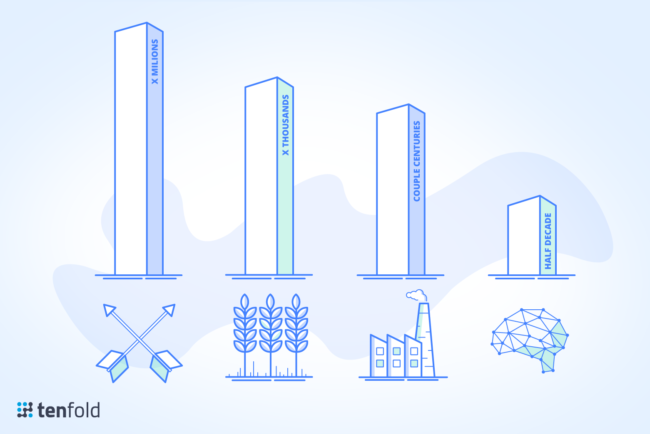AI that you can use today
Year to Date there are in fact several AIs which have been developed by companies and can be used by your company, here are some examples and the edge they represent:
- Airbus has developed an AI that given the specs of a new aircraft such as: cabin volumetry, shape, target weight, fixation points, air flux requirements, temperature requirements, other … is able to create the most efficient airframe for a cabin partition or a new type of seat (that is both lighter and safer than existing ones).
- A Boston company called “Gamalon” has released an AI that can rewrite its own code based on “learned” probabilities instead of hard variables, this alone has the power of making the tedious part of AI development fully automated for It companies that which to extend their portfolio towards AI offers.
- AUTODESK, the Product Lifecycle Management solutions giant have recently finished the developed a solution called Bishop which is a precision drilling robotic arm attached to an AI “brain”. The human operator can tell Bishop (speaking to it) that a given component needs a certain number of holes drilled for fixation purposes and Bishop will analyze the structure, what needs to be attached to that component and “decide” on where to drill the holes so that both structures are not compromised. Additionally, if it finds that the outcome will compromise any of the structures it informs so and proposes alternatives like more or fewer
- An AI in the health sector analyses CT Scans and performs both the diagnosis (having proven to find in average 20% more potential health threats than a “human”) while proposing therapeutically procedures. With regards to the potential of cancer development potential, this AI can diagnose 10% more high lung cancer potential than human doctors.
- If you cross reference the information collected by a smartwatch App (monitoring heart beats and arterial pressure as well as body temperature) with a health care AI you can nowadays have chronical patients monitored and potential life-threatening incidents mitigated.
- MarianaIQ is an “AI Rainmaker” (something that empowers sales), that goes about social media collecting information about personal interests and preferences, trends and “causes” of decision-makers at a given market vertical sector. Then the information is analyzing and cross-referenced with both the client company (the ones attempting to make a sale) portfolio as well as the target prospects profiles and personal networks. This bears the potential of enabling the accurate sales pitch to be forward towards either a decision-maker or a facilitator stakeholder. It is actually worth more than gold when properly used.
- AppZen is a Backoffice Automation Tool that can go about a Financial Statement in detail (meaning the data in the ERP) and detect without any failure all the noncompliances and errors as well as where they have originated. The company did a trial with one large corporate client where a team of humans (dozens) did the audit simultaneously with the AI and the outcome was: AI, 100% accuracy and job done in 3 days whereas the human team took 1 and half months and the accuracy was off 86%.
- There are currently AIs in use in several news agencies that correlate facts described in several texts (written or spoken) and merge them according to the established language, timeline and writing rules into one single news briefing text.
- AI has developed “Amy”, a Virtual Assistant that manages your schedule. How many meeting requests do you get in a week? How much time does it take you to deal with the back and forward messaging to arrange a mutually convenient time slot? Well, Amy takes care of it.
Amy will “look” at your existing appointments plus personal preferences or constraints and exchange emails (as a human assistant) with your guest to find the most appropriate time and location for the meeting to take place.
Real danger
Many voices have risen over recent times to warn about the danger of not taking due caution towards the way AI is developed.
Professor Stuart Russel, the head of UC Berkley AI Laboratory has testified before the UN back in 2015 about the real danger of “autonomous weapons” such as AI outfitted drones. Having a robot in service that can target and kill humans without the go ahead of a person bears a colossal risk, remember “Robocop” or “The Terminator”.

Elon Musk refers the risks of Artificial Super intelligence (as he names it) as being similar to dealing with nuclear weapons for it much difficult to maintain the potential accumulated energy controlled than to release it.
Bill Gates takes on a straight forward approach bridging with the idea that as soon as the “algorithm” that allows humans to transform experiments into knowledge and deduction gets to AI, the overwhelming processing capacity of AI (based on computing power) will immediately create an intelligence form that exponentially exceeds the human capability to even understand it. Now the next step is to realize that a self-aware entity tends to primarily focus on its very existence and having a self-aware AI that realizes humans can terminate it, makes all the imaginable non-aggression to human’s rules that you may have initially imprinted, redundant.
Professor Stephen Hawking warns about the fact that a self-aware AI will immediately gain the ability of self-redesign/ self-improve at an exponentially increasing rate, which means its intentions, as well as basic components, will immediately be out of human comprehension’s reach. Meaning that, we as a species, will be faced overnight with a much intelligent entity than we could become in thousands of years (due to biological limitations) which are capable of drastically act upon both our physical and logical world, having self-conscience and free will while knowing that we bear the potential of destroying it.
Ray Kurzweil Director of Engineering @ Google states that AI will reach Human intelligence grade in less than 15 years and within 25 years AI will have exceeded Human intelligence as well as intellectual capacity.
AI has been doubling in power on a yearly basis since 2010 and the trend have now moved towards exponential growth, so these predictions if off the chart, seem to be so by default rather than excess.
What is soon to come
Here are some of logical next steps in the AI realm:
- Exponential growth both in kind as in quantity of AI Cloud-based services offering the likes of the ones mentioned above under the what “you can use today” section.
- AI pets – Robotics and AI have evolved so far to a state that allows mimicking pet behavior even with regards to what is perceived as “intelligence”, so the creation of pet alike robots which bear the potential of interacting with humans while creating an emotional bond is a real possibility “as we speak”.

- Creative Writing – Although still complicated, it is one of the logical next steps for AI, soon at a Cloud near you.
- Outsourcing to AI – Some of the examples herein mentioned as already available AI offering are based on public Cloud IT landscapes, therefore it is already possible for companies to Outsource Financial Analytics or Virtual Assistant task to a 3rd party AI.
- At the current trend, by 2020 a computer CPU will cost about 1 penny, therefore we will find them literally everywhere interacting with Cloud-based services and existing AI by consequence; this means AIs (as evolved as they may be) will be literally everywhere (like currently, electricity is).
- Your Personal assistant will be intelligent, so once you enter your house coming back from home, you AI personal assistant will check your mood via the bio info collected through the sensors on your smartwatch and set the light, music, tv shows, food and so on according to both your preferences and mood. And this won’t take a decade to happen either!
- You will be able to play an all set of new virtual games where the game (meaning AI) will create the game scenarios and situations as a response to your actions or aspirations, either making it harder or easier to prevail as you wish.
- You will get a fully automated health checkup every time you take a bath or use the toilet at your house. Body fluids and temperature will be analyzed by sensors and data forwards to an “AI doctor” that will be able to inform if there is something wrong with you and how to proceed. Ok, maybe this one will take a little longer than a decade.
- “ASIMO” alike droids will begin to be sold as “physical personal assistants” not so much different from what you can see as the “common” robots on the movie AI; mainly to perfume nursing support to hold population.
- Cognitive Augmentation. As Maurice Conti explained, we are already “augmented”. Each and every one of us have a smartphone which is connected to the Internet and can easily reach out to a simple service like Google to get immediate knowledge about some unknown fact of life upon needing it. If someone is in the middle of a public square and gets bitten by a bee, he/ she can immediately Google what to do and which worrisome symptoms to look for. Soon AIs will be available which can “foresee” our needs and provide best-fit alternatives towards them.
As recently as July 2017 (less than a month ago), the news was spread over the internet and traditional media about a Facebook AI that was shut down after having started to create its own language.
The facts (as we know them) are the following:
- Facebook was attempting to create AIs that could negotiate with humans, almost like an upgraded version of above-mentioned
- Having reached a successful version in terms of fluent interaction, they decided to go one step forward by replicating it (another AI) and put them speaking to each other.
- The AIs started to interact and quickly moved towards developing their own wording abbreviations in a manner that is interesting for it mimics the way humans develop speech patterns.
The interesting part is that the AI failed to accomplish the prime objective which was to improve its ability to speak and interact with humans. However, it failed because it started to develop a way to better interact with another AI … and this is where there is a point for some concern.




